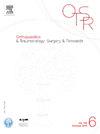Zirconia ageing is related to total hip arthroplasty aseptic loosening. A study of 45 retrieved zirconia heads.
IF 2.3
3区 医学
Q2 ORTHOPEDICS
引用次数: 0
Abstract
BACKGROUND Y-TZP zirconia heads were recalled by the Food and Drug Administration (FDA) in 2001 and zirconia alone was no longer used in orthopedics. Tunnel furnace sintering was suspected of producing defects responsible for early material failure. As Zirconia Toughened Alumina (ZTA) matrices are widely used as bearing material and contain zirconia grains, there remains a need to better understand the in vivo ageing process of zirconia and its clinical implications when the material is produced by batch furnace sintering, the validated sintering process. QUESTIONS/OBJECTIVES Is there an association between the ageing of batch furnace produced zirconia and THA revision? METHODS 45 retrieved femoral heads, batch furnace sintered only, were analyzed. Roughness was measured by 3D profilometry, phase transfer by μRaman spectroscopy. Clinical data were compared with material characteristics. RESULTS Irrespective of the cause of revision, all heads showed a crystallographic phase transition from tetragonal to monoclinic over 19.5%. A correlation was found between the phase change, roughness increase and aseptic loosening, with a threshold set at 24.5% of monoclinic phase. CONCLUSIONS The ageing process of zirconia may lead to aseptic loosening, which, in the absence of contrary evidence, prohibits its use as the sole component of orthopedic materials. ZTA matrices should be clinically monitored, especially in young patients, and better in vitro modelling needs to be performed. LEVEL OF EVIDENCE IV; Case series.氧化锆老化与全髋关节置换术无菌性松动有关。对 45 个回收的氧化锆头的研究。
背景-TZP 氧化锆头于 2001 年被美国食品药品管理局(FDA)召回,氧化锆已不再单独用于整形外科。隧道炉烧结被怀疑会产生导致材料早期失效的缺陷。由于氧化锆增韧氧化铝(ZTA)基质被广泛用作承载材料,并含有氧化锆晶粒,因此仍有必要更好地了解氧化锆的体内老化过程及其对通过批量炉烧结(有效的烧结工艺)生产的材料的临床影响。问题/目的:批量炉生产的氧化锆的老化与 THA 翻修术之间是否存在关联? 方法:分析了 45 个仅在批量炉中烧结的回收股骨头。粗糙度用三维轮廓仪测量,相转移用μRaman光谱仪测量。结果无论翻修原因如何,所有股骨头都有超过 19.5% 的结晶相从四方晶转变为单斜晶。结论氧化锆的老化过程可能导致无菌性松动,在没有相反证据的情况下,禁止将其用作矫形材料的唯一成分。应在临床上对 ZTA 基质进行监测,尤其是在年轻患者中,并且需要进行更好的体外建模。
本文章由计算机程序翻译,如有差异,请以英文原文为准。
求助全文
约1分钟内获得全文
求助全文
来源期刊
CiteScore
5.10
自引率
26.10%
发文量
329
审稿时长
12.5 weeks
期刊介绍:
Orthopaedics & Traumatology: Surgery & Research (OTSR) publishes original scientific work in English related to all domains of orthopaedics. Original articles, Reviews, Technical notes and Concise follow-up of a former OTSR study are published in English in electronic form only and indexed in the main international databases.

 求助内容:
求助内容: 应助结果提醒方式:
应助结果提醒方式:


